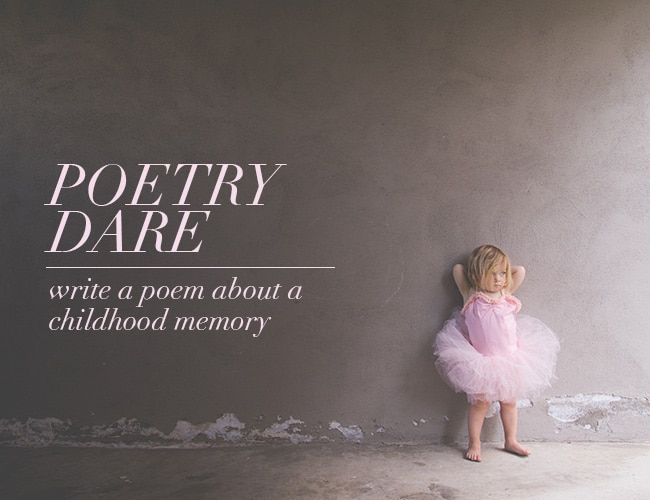It’s National Poetry Month! I know, I know. You don’t want to write a poem, but what if I could show you a way to tap into a childhood memory to create a poem or scene that you could use in any kind of writing? Will you accept a poetry dare today?

Write a Poem as Practice
Even if poetry is not your favorite or preferred genre, writing one is great practice. Too many writers get hung up on ideas, rhyming, and form in trying to create some obscure meaning in poems. Let’s simplify it and do a little practice that will help you in any genre you pursue.
Poetry uses precise words for a specific effect, usually depending on images to evoke emotions. We want to tap into finding precise words that create concrete images today. If you’ve ever received the note, “More show, less tell” in your writing, then this exercise is for you.
Find Inspiration
In Mystery and Manners: Occasional Prose, Flannery O’Connor said, “Anybody who has survived his childhood has enough information about life to last him the rest of his days.”
Using her advice, let’s tap into a childhood memory to create a poem today. (I see your I-don’t-write-poetry eyeroll. The brainstorming alone will help your prose. C’mon, I double-dog-dare you.) There are only two rules:
1. Choose specific, concrete words by thinking about sensory details.
2. Finish the exercise no matter what your inner critic says.
Gather Ideas
Think back to a childhood home. It doesn’t have to be yours, but it should be somewhere you spent considerable time where you have vivid memories. Can you picture it?
In your mind, see the street it sits on, the front of the building, and the front door. Jot down a few details including any colors or what season it is. Imagine your hand on the front door. What do you smell? What emotions fill you in that split second before you turn the handle?
Go inside. Look around the rooms you remember best. How does the kitchen smell? Like bologna sandwiches or pancakes? Maybe you run straight through and to the backyard.
Maybe wander into your old bedroom. What does it look like? Is it tidy? Unkempt? Are your shoulders tense or relaxed and why? Do you hear voices or silence or the banging of the radiator that kept you up at night? Write it all down.
Think about the spaces you avoided and why. Describe them including what you see, what you taste, what you smell. What time of day is it?
Now take a deep breath and find your favorite spot in or around that home. What objects or people are there? What season is it? How old are you? Describe it through the eyes of a child.
Select Concrete Details
Once you have a list describing the various places and experiences around that home, choose the details that are most vivid or a story from one of the spaces to explore.
Some of my students tackle this task by drawing a map of their childhood home and listing the details in rooms or drawing specific objects they remember. Some annotate stories that happened in specific places.
On my own childhood home doodles, I have things from the yard like “the mud pit that ruined Mandi’s new Miss Piggy shoes” and “dingy white storage shed with the broken lock and swaying spider webs.”
Choose details that create vivid images in the reader’s mind. Make sure to include smells, which are often overlooked in writing, but add rich associations.
Simple Structure
One of the simplest ways to structure a poem or experience is using “I remember, I remember, I remember, but mostly, I remember” to create four stanzas.
I remember …
I remember …
I remember …
But mostly I remember …
You can make the stanzas as long or short as you want, using phrases, fragments, or full sentences, but fight to use the most precise, concrete, sensory words you can muster (remember rule one from above?).
I’m writing about the childhood prank my neighbor and I planned in the dirt between our yards one day when we dug a three foot by four foot hole, filled it with dirt and water until it was a muddy mess, and then recovered it with dry granite and pine needles. We waited for his mom to get home with his sister so we could lure her into our mudhole.
When they drove up, his sister bounded out of the car unexpectedly wearing brand new white and pink Miss Piggy shoes, and we were in deep trouble.
My Example Stanza of “I Remember”
But mostly I remember the buzz of horror and excitement as Mandi squealed with delight
Her leather pink and white tennis shoes emblazoned with Miss Piggy strided toward us
“Look at my new shoes!”
Her brother and I looked at each other in fear as she hopped the rail fence
We held our breath
Would she launch into the brown, sticky pit? Would we let her?
She jumped from atop the fence and straight into our muddy trap,
Her face distorting as her eyebrows frowned, her cheeks flamed red, her eyes bulged
Both feet splooging into the mud, she sank in up to her knees, a cry erupting
“Mooooooooooommmmmmm!”
We took off running for the woods, his mother’s shriek crying out at our backs
Only when we were deep in the fragrant pines did we stop to catch our breath
He looked over at me, my hands on my knees, sweat trickling from my brow
“It was worth it,” he said through broken breaths, a smile
I only nodded in reply, resting against the rough bark of the Ponderosa Pine
Your Turn
Is this a great poem? No, not yet, but it does have some images that capture the essence of place and childhood.
This short exercise might work its way into a personal essay, a memoir, or a similar flashback scene in a novel. It might remain in my notebook as practice, but as deliberate practice, it forced me to choose descriptive images to relate an experience instead of relying on telling words which will strengthen anything I write.
Give it a try today and write a poem, either mining your own childhood experiences or the imagined childhood experiences of your protagonist. Share your favorite stanza in the comments!
What do you find challenging about writing poetry? Let us know in the comments.
PRACTICE
Take fifteen minutes to write your own poem. First, think through your memories of a home from your childhood. Then, choose one of those memories and write about it in an “I remember . . .” poem format. Focus on using specific, concrete words to describe the experience.
When you're done, share your poem in the Pro Practice Workshop, and be sure to leave feedback for your fellow writers!
Sue Weems is a writer, teacher, and traveler with an advanced degree in (mostly fictional) revenge. When she’s not rationalizing her love for parentheses (and dramatic asides), she follows a sailor around the globe with their four children, two dogs, and an impossibly tall stack of books to read. You can read more of her writing tips on her website.




0 Comments